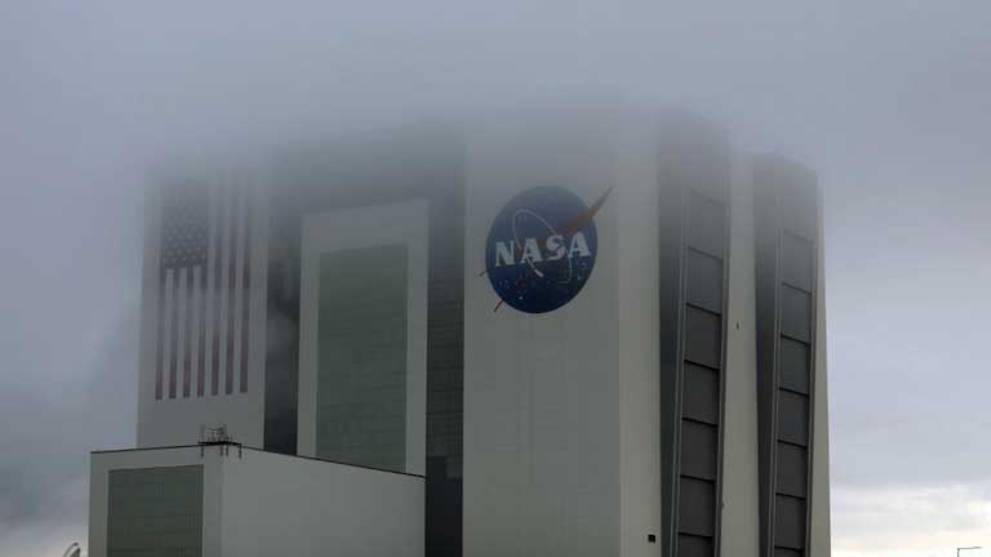
Bad weather threatens SpaceX's first crewed mission
CAPE CANAVERAL, Florida: Inclement weather threatened on Wednesday (May 27) to postpone SpaceX's launch into orbit of two NASA astronauts, a historic first for a privately-owned company and the first crewed mission to blast off from US soil in almost a decade.
A thunderstorm lashed the Kennedy Space Center in the morning, and the National Hurricane Center announced a tropical storm was forming off South Carolina, presenting a possible risk if astronauts are forced to carry out an emergency landing in the Atlantic shortly after takeoff.
READ: Tropical storm makes landfall, bringing heavy rain to South Carolina
NASA and SpaceX officials will meet in the morning to determine whether or not to postpone to Saturday, the next possible launch window.
"Yeah, Atlantic weather review tomorrow morning will determine if we can launch," tweeted Elon Musk, the head of SpaceX, who has been waiting for this moment ever since founding his company in 2002.
For the moment, takeoff remains scheduled for 4:33 pm (20:33 GMT) from the Kennedy Space Center's Launch Pad 39A, the same from which Neil Armstrong and his Apollo 11 crewmates lifted off on their historic journey to the Moon.
Piloted by NASA astronauts Bob Behnken and Doug Hurley, the SpaceX Crew Dragon capsule will head for the International Space Station.
The mission has proceeded despite shutdowns caused by the coronavirus pandemic, with the crew in quarantine for the past two weeks.
Space Exploration Technologies Corp. was founded in 2002, tearing up the rules to produce a lower-cost alternative to human spaceflight that has gradually won over skeptics.
By 2012, it had become the first private company to dock a cargo capsule at the ISS, resupplying the station regularly ever since.
Two years later, NASA ordered the next step: to transport its astronauts there, starting in 2017, by adapting the Dragon capsule.
"SpaceX would not be here without NASA," said Musk last year, after a successful dress rehearsal without humans for the trip to the ISS.
The space agency paid more than US$3 billion for SpaceX to design, build, test and operate its reusable capsule for six future space round trips.
The project has experienced delays, explosions, and parachute problems - but even so, SpaceX has beaten aerospace giant Boeing to the punch.
NASA is also paying Boeing to build its own capsule, the Starliner, which is still not ready.
The move by NASA to invest in privately-developed spacecraft - a more economic proposition than spending tens of billions of dollars developing such systems itself, as it had done for decades - was begun under the presidency of George W. Bush for cargo, and then under Barack Obama for human flight.
"Some have said it is unfeasible or unwise to work with the private sector in this way. I disagree," Obama said in 2010 at the Kennedy Space Center.
At the time, there was immense hostility in Congress and NASA to the start-up's claims of what it could achieve.
TRUMP TO ATTEND
A decade on it is another president, Donald Trump, who will attend Wednesday's launch in Florida.
The Republican is trying to reaffirm American domination of space, militarily but also by ordering a return to the Moon in 2024.
If NASA can entrust "low Earth orbit" space travel to the private sector, it would free up dollars for its more distant missions.
"We envision a future where low Earth orbit is entirely commercialized where NASA is one customer of many customers," said Jim Bridenstine, the agency's administrator.
"If we keep using American taxpayer dollars ... we'll never get to the Moon and on to Mars."
Crew Dragon is a capsule like Apollo, but updated for the 21st century.
Touch screens have replaced switches. The interior is dominated by white, more subtle lighting.
It looks entirely different than the huge winged space shuttles that carried astronauts into space from US soil from 1981 to 2011.
"We're expecting a smooth ride but we're expecting a loud ride," said Behnken, who, like Hurley, also flew in the shuttles twice.
Unlike the shuttles, one of which - the Challenger - exploded in 1986 after take-off, Dragon can eject in an emergency if the Falcon 9 rocket has a problem boosting it into space.
Crew Dragon will catch up with the space station on Thursday at an altitude of 400 kilometres, and will probably remain docked there until August.
If it fulfils its mission and is certified safe, it will mean the Americans will no longer depend on Russia for access to space: since 2011, the Russian Soyuz rockets were the only space taxis available.